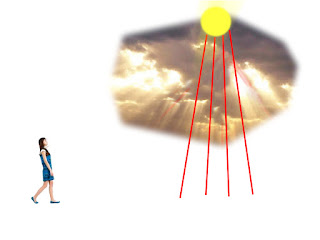Point 125 “Another proof the Sun is not millions of miles away is found by tracing
the angle of sun-rays back to their source above the clouds. There are
thousands of pictures showing how sunlight comes down through cloud-cover at a
variance of converging angles. The area of convergence is of course the Sun,
and is clearly NOT millions of miles away, but rather relatively close to Earth
just above the clouds.”Point 125 “Another proof the Sun is not millions of miles away is found by tracing
the angle of sun-rays back to their source above the clouds. There are
thousands of pictures showing how sunlight comes down through cloud-cover at a
variance of converging angles. The area of convergence is of course the Sun,
and is clearly NOT millions of miles away, but rather relatively close to Earth
just above the clouds.”
Because we see lines of light
through gaps in cloud, splaying out at angles from the bright centre, very
foolish people think you can just trace back thie apparent path upwards where these lines seem to meet
and somehow prove that the sun is very close.
I’m sure lots of you can see what
is wrong with this, but here is why. When we see lines converge to a point, it
doesn’t mean that they are actually at the angle that they seem to be. Every
adult knows that’s true from their experience.
It’s particularly odd that Mr Dubay
should make this argument because back at point 6 he used this picture:

Have you never stood on a long
straight track, perhaps a railway or road, and seen the edges or rails seem to
converge on a point some distance away. Did that make you think that the
railway lines actually do meet up just a
little way down the track. Of course not. It’s called perspective, folks.
When Dubay shows us this:
He doesn’t expect us to believe we
are seeing this:
So when he shows us this:
Why does he expect us the believe that we are really seeing this?
Does he expect us to believe that
these rails really do meet at a point out there by the horizon? Or else rise up
in the air in a triangle?
We know that in reality the rails
are parallel and the convergence is an illusion caused by perspective.
If we saw the bars of light and
shadow from above, from an aircraft, we would see that they are parallel, like
this:
And here is just such an aerial photograph
The radial appearance of sun
rays is a very simple effect of perspective. Every long pair of parallel lines
will appear to stretch out as you get closer to them. Railroad tracks are a
good example. You won't be able to tell any distance just by making the two
lines seemingly converge.
If you looked at the sun rays in the following picture from sea-level, they would appear to be converging at the clouds, but they are not:
If you looked at the sun rays in the following picture from sea-level, they would appear to be converging at the clouds, but they are not:
Even this flat earther got it right:
https://www.youtube.com/watch?v=7aQktHTP0-U#t=04m22sFor a good explanation of crepuscular ray (which is what these are called) see here and for anti-crepuscular rays (going upward) see here.
There is a good discussion here
Those bars of sunlight shining
through cloud are actually parallel, like the railway tracks. But some go past
you on the left, some on the right, some above, and some straight into your
eyes, dazzling you.
If Mr Dubay’s diagram made any
sense, then railway rails seen from above would join up into a point, a long
narrow triangle, and all trains would derail.
By the way, if reason doesn’t show
you that parallel lines often form the appearance of converging into triangles,
here is a link to a photograph of such a
cloud formation, that should make the point.

Here is an animation made in Sketchup to show why the flat earth claim makes no sense:
https://www.metabunk.org/crepuscular-angles-and-the-flat-idea.t7360/#post-185929
There is a lot more useful information in the Metabunk thread
There are ways to measure and demonstrate the Sun and moon’s distances.
There is a lot more useful information in the Metabunk thread
There are ways to measure and demonstrate the Sun and moon’s distances.
The sun’s distance:
The moon’s distance







No comments:
Post a Comment
(Please make your comment reasoned and based on evidence . Abusive comments will be totally ignored.)